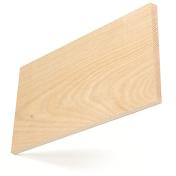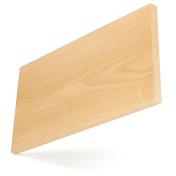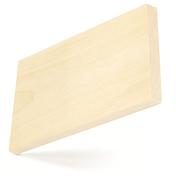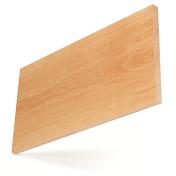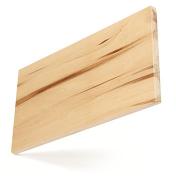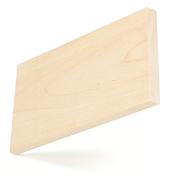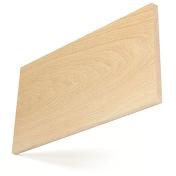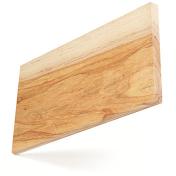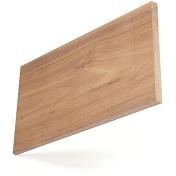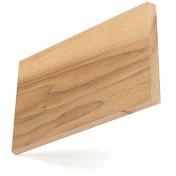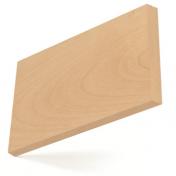Compare Species
Select two species for a detailed comparison.
American red oak

Forest Distribution
Red oak trees grow only naturally and almost exclusively in North America, although planted elsewhere. They are widely distributed throughout most of the eastern United States in mixed hardwood forests. The trees are very tall. There are many sub-species, all within the red oak classification, which grow from north to south; some high in the mountains and others on low land giving rise to different characteristics. Thus there are significant variations in red oaks depending on location, in particular between the slower grown northern and faster grown southern trees. Red oaks are regarded as highly sustainable for both domestic and export consumption and, being the largest species group, are more abundant than the white oaks.
FOREST GROWTH
FIA data shows U.S. red oak growing stock is 2.62 billion m3, 18% of total U.S. hardwood growing stock. American red oak is growing 60.6 million m3 per year while the harvest is 31.9 million m3 per year. The net volume (after harvest) is increasing 28.7 million m3 each year. U.S. red oak growth exceeds or is in balance with harvest in all states except Texas.
Material Availability
Red oak from the USA is readily available as sawn lumber and veneer, in a wide range of grades and sizes. Thicker lumber (10/4" & 12/4") can be sourced in relatively small volumes from specialist suppliers, but is widely produced through out the hardwood industry from 4/4" (25.4mm) through to 8/4" (52mm). In the north the sapwood tends to be less due to the shorter growing season, than in the south where the wood is grown faster with more open grain and texture. Red oak may be sold on the basis of 'northern' and 'southern', but this may be an over-simplification of the differences according to growing location.
Wood Description
- In general the sapwood of red oaks is light brown and the heartwood is often, but not always, pinkish to reddish brown. The colour difference between the sapwood and heart wood is quite distinct. The wood of red oaks is generally straight-grained and coarse textured.
- The wood is figured with medullary rays – a feature of all true (Quercus) oaks – smaller in red oak than white oak. The wood is porous, and easily identified from the end grain, so not suitable for wine barrels.
Mechanical Properties
American red oaks have very good overall strength properties relative to weight. The wood is hard and heavy with medium bending strength, stiffness and high crushing strength. It has excellent steam bending capability. Being hard, stable when dry and easy to finish and stain, it is ideal for furniture and flooring.
To find out more about the mechanical properties of red oak read the full structural guide.
-
Quercus Rubra
0.63
Specific Gravity (12% M.C.)
705 kg/m3
Average Weight (12% M.C.)
6.6%
Average Volume Shrinkage (Green to 6% M.C.)
98.599 MPa
Modulus of Rupture
12,549 MPa
Modulus of Elasticity
46.610 MPa
Compressive strength (parallel to grain)
5,738 N
Hardness
-
Quercus Falcatta
0.68
Specific Gravity (12% M.C.)
753 kg/m3
Average Weight (12% M.C.)
N/A
Average Volume Shrinkage (Green to 6% M.C.)
75.156 MPa
Modulus of Rupture
10,274 MPa
Modulus of Elasticity
41.991 MPa
Compressive strength (parallel to grain)
4,715 N
Hardness
Oiled / Un-Oiled Appearance


Performance
Red oak lumber machines well, with good performance in nailing and screwing, although pre-boring is recommended. It glues well and can be stained and polished to a very good finish. Being porous, red oak absorbs all treatments. The wood dries best slowly to minimise degrade, but with high shrinkage and can be susceptible to movement in performance in humid conditions. The wood is rated as slightly resistant to heartwood decay, but moderately easy to treat with preservatives. This makes red oak suitable for being thermally modified.
Main Uses
This sustainably managed species group from natural forests of North America, with excellent environmental credentials, is a key species in many export markets. Its main uses are in furniture, flooring, doors, architectural joinery, mouldings and kitchen cabinets. It is also used in certain applications for construction.
American alder
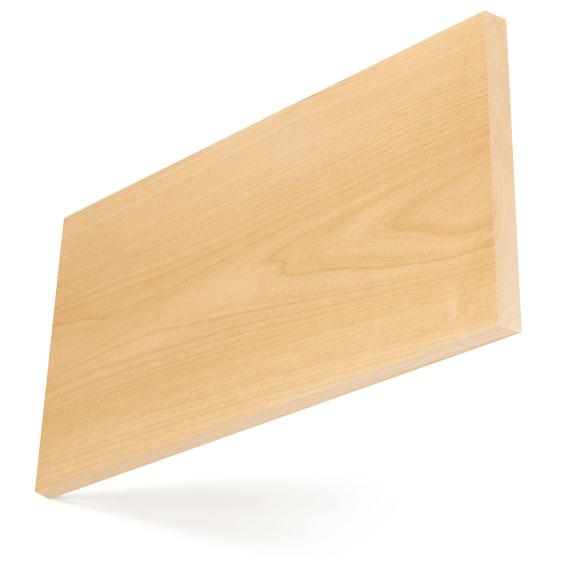
Forest Distribution
American alder trees grow prolifically in the Pacific Northwest under sustainable management. Alder has a relatively short rotation, taking less time to harvest than most other hardwoods.
Material Availability
- lder is graded using NHLA Pacific Coast Red Alder Rules published in the “NHLA Rules for the Measurement and Inspection of Hardwood and Cypress”. The key grading points include grading from the better face rather than poor side as in the Standard NHLA Grading Rules; pin knots are regarded as character and no defect. The primary grades include Superior (Select and Better), Cabinet (No. 1 Common) and Frame (No. 2 Common) that are similar to uses as for the standard NHLA grades.
- Alder from the USA is readily available as kiln dried sawn lumber and often sold under a range of unique grading rules, for grades not listed in the NHLA Rules, consultation with suppliers is recommended.
- Lumber may be sold rough sawn or planed as dimension stock. It has limited availability as veneer.
Wood Description
Alder is almost white when freshly cut, but quickly changes on exposure to air, becoming light brown with a yellow or reddish tinge. There is no visible difference between the sap and the heartwood, although heartwood is formed only in older or mature trees. The wood of alder is fairly straight grain, somewhat similar in character to cherry, with uniform texture.
Mechanical Properties
Alder has medium density, but is relatively soft. It has low bending strength, shock resistance, and stiffness. It is easily turned and can be polished and stained to an excellent finish.
-
0.41
Specific Gravity (12% M.C.)
449 kg/m3
Average Weight (12% M.C.)
10.10%
Average Volume Shrinkage (Green to 6% M.C.)
67.571 MPa
Modulus of Rupture
9,515 MPa
Modulus of Elasticity
40.129 MPa
Compressive strength (parallel to grain)
2,624 N
Hardness
Oiled / Un-Oiled Appearance


Performance
- Alder machines easily and is good for planing, drilling, boring, carving, moulding, nailing, screwing and gluing, making it highly suitable for furniture and joinery.
- The wood is non-resistant to heartwood decay but is permeable to preservative treatment.
Main Uses
- This prolific hardwood from the Pacific Northwest, with excellent environmental credentials, is used for furniture, kitchen cabinets and interior joinery. It is also used for doors and panelling.
- The grain pattern and colour of alder makes it suitable as a substitute for cherry.
American ash

Forest Distribution
American ash trees grow commonly throughout the eastern United States in mixed hardwood forests, from the north in New York State to the southern States along the Gulf of Mexico, and everywhere in between. They grow high in the mountains and low on the plains and coastal areas giving rise to great variety of character. With such widespread distribution in latitude, climate and soil conditions, there are significant variations in ash depending on location, in particular between the slower grown northern and faster grown southern trees. There are also sub-species that add to this variety. Despite some longer-term threats by forest pests and disease to the ash standing stock of timber, ash is a prolific species.
FOREST GROWTH
Forest Inventory Analysis (FIA) data shows U.S. ash growing stock is 657 million m3, 4.5% of total U.S. hardwood growing stock. American ash is growing 3.3 million m3/per year while the harvest is 6.9 million m3 per year. Net volume (after harvest) is increasing -3.5 million m3 each year. The 2014 inventory indicates that U.S. ash growth exceeds harvest in all major supplying states except Michigan and Ohio, which are central to the Emerald Ash Borer (EAB) infestation. Ash mortality rates and removals are expected to rise in the immediate future, likely in excess of growth in some states, due to the EAB infestation.
Material Availability
- Ash from the USA is readily available as sawn lumber and veneer, in a wide range of grades and sizes. In the north the sapwood tends to be less due to the shorter growing season, than in the south where the wood is grown faster with more open grain and texture. Ash may be sold on the basis of colour and is widely available for export. Ash was the 4th major American hardwood species to be exported worldwide by volume in 2015.
- Ash lumber is available in a range of grades from 4/4” (1” or 25.4mm) through to 8/4” (2” or 52mm) although limited volumes of 10/4” (2.5” or 63mm) and 12/4” (3’ or 75mm) can be sourced.
Wood Description
- In general ash is a light coloured wood, with sapwood varying from white to yellow and heartwood light to dark brown, sometimes with lighter streaks. The colour difference between the outer light-coloured white sapwood and inner, darker, even brown heartwood is quite distinct. Ash wood is generally straight-grained with a coarse uniform texture. Its appearance has a very strong grain contrast between the softer summer growth and hard winter growth rings. No two pieces are ever the same in appearance.
- Light brown flecks, or mineral streaks, sometimes referred to as ‘glassworm’, are common in ash and are treated as a natural characteristic, and are not considered as a defect under the NHLA Grading Rules. They do not undermine the integrity of the wood.
Mechanical Properties
Ash wood has very good overall strength properties relative to its weight. It has excellent shock resistance, which takes some of the pain from those using hand tools and sports equipment, such as baseball bats. It steam bends very well, so is a favourite of furniture makers and hobbyists. Being very hard, stable when dry and easy to finish and stain, it is ideal for furniture and flooring.
To find out more about the mechanical properties of ash read the full structural guide.
-
0.6
Specific Gravity (12% M.C.)
673 kg/m3
Average Weight (12% M.C.)
10.70%
Average Volume Shrinkage (Green to 6% M.C.)
103.425 MPa
Modulus of Rupture
11,977 MPa
Modulus of Elasticity
51.092 MPa
Compressive strength (parallel to grain)
5,871 N
Hardness
Oiled / Un-Oiled Appearance


Performance
Ash lumber machines well, with good performance in nailing, screwing, gluing and can be stained and polished to a very good finish. Black stained ash has experienced several successful fashion cycles in furniture. The wood dries fairly easily with minimal degrade. With good stability there is not much movement in performance. Ash veneer laminates well to board materials. Ash is not resistant to heartwood decay and the heartwood is moderately resistant to preservative treatment, but the sapwood is permeable. This makes ash very suitable for being thermally modified, as has now been proven through its widespread use for decking, cladding, worktops and garden furniture.
Main Uses
This sustainably managed wood from natural forests of North America, with its excellent environmental credentials, is popular with designers, architects, specialist users and consumers around the world. Its main uses are furniture, flooring, doors, architectural joinery and mouldings, kitchen cabinets, tool and sport handles.
American aspen

Forest Distribution
American aspen trees grow in dense stands that are easily sustainable but are commercially less important than some other American hardwoods.Tress can grow up to 120ft (48m) and up to 4ft (1.2m) in diameter. Due to genetic variability trunks can either be quite cylindrical with little taper and few limbs, or crooked and contorted. Aspen is one of the species that benefits from clear-cutting to regenerate, being shade intolerant, and regrows both from seedlings and root suckers. It is a natural pioneer species after forest fires. The four main aspen producing states are Minnesota, Wisconsin, Maine and Michigan.
FOREST GROWTH
Forest Inventory Analysis (FIA) data shows U.S. aspen growing stock is 637 million m3, 4.3% of total U.S. hardwood growing stock. American aspen is growing 10.4 million m3 per year while the harvest is 8.9 million m3 per year. The net volume (after harvest) is increasing 1.5 million m3 each year.
Material Availability
Aspen from the USA is available as sawn lumber and veneer. Lumber tends to be available mainly in thinner sizes, 4/4” (1’’ or 25.4mm) and 5/4” (1.25” or 32mm), although limited volumes of 6/4” (38mm) and 8/4” 52mm may be available from some suppliers.
Wood Description
The sap of aspen is white and the heartwood is light brown with only a small difference between the two. The wood of aspen has a fine uniform texture and straight grain.
Mechanical Properties
Aspen has low density and the wood is light and soft. It has a very low bending classification with low strength and stiffness but has medium shock resistance.
-
0.38
Specific Gravity (12% M.C.)
417 kg/m3
Average Weight (12% M.C.)
9.20%
Average Volume Shrinkage (Green to 6% M.C.)
57.918 MPa
Modulus of Rupture
8,136 MPa
Modulus of Elasticity
29.304 MPa
Compressive strength (parallel to grain)
1,557 N
Hardness
Oiled / Un-Oiled Appearance


Performance
- Aspen machines easily but can produce a slightly fuzzy surface when cut. It does not split when nailed and it turns and sands fairly easily and holds paint and stain well to produce a good finish, but care is needed where the surface is fuzzy. Aspen has low to moderate shrinkage and good dimensional stability. It is similar in performance to other true poplars grown around the world.
- The wood is non-resistant to heartwood decay and is resistant to preservative treatment.
Main Uses
This fast growing hardwood, which is common across the USA, is used for furniture parts, particularly drawer sides. It is also used in a variety of applications including doors, interior joinery, mouldings and picture frames. Specialist uses include seating in saunas due to its low conductivity of heat and in food packaging and chopsticks due to lack of odour and taste. Aspen is also used for pulp for paper.
American basswood
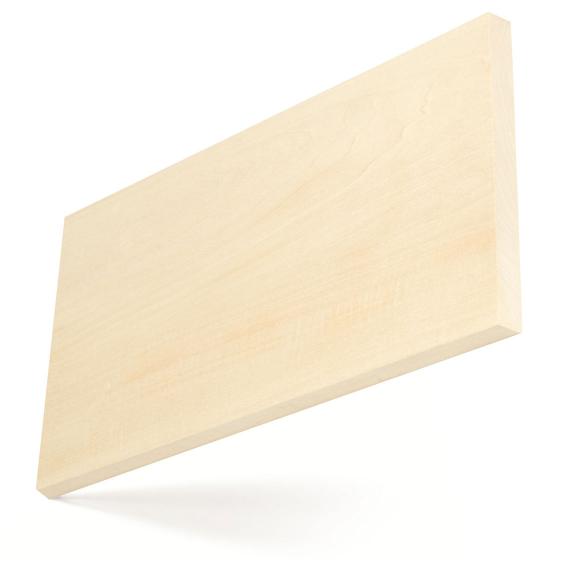
Forest Distribution
American basswood is botanically related to the lime tree found in Europe. The trees are generally large in height and diameter, often with straight trunks and relatively free of limbs. Basswood can be found growing throughout the USA in natural hardwood forests.
FOREST GROWTH
Forest Inventory Analysis (FIA) data shows U.S. basswood growing stock is 210 million m3, 1.4% of total U.S. hardwood growing stock. American basswood is growing 3.3 million m3 per year while the harvest is 1.7 million m3 per year. The net volume (after harvest) is increasing by 1.6 million m3 each year. U.S. basswood growth exceeds or is in balance with harvest in all the main producing states.
Material Availability
Basswood from the USA is available in relatively limited volumes compared to some other species, both as sawn lumber and veneer. Lumber is available in a range of grades and thickness from 4/4” (25.4mm) right through to 16/4” (102mm) due to its ease of drying. Basswood lumber is also available in 9/4” (56mm) a specially produced thickness for production of window shutters and venetian blinds.
Wood Description
The sap of basswood tends to be large and is creamy white in colour giving way to the heartwood that is pale to reddish brown. It may display dark streaks which are not a defect. The difference between sap and heartwood is small and may be indistinct. The wood of basswood has a fine uniform texture and straight grain, which is not distinct.
Mechanical Properties
Basswood is light and soft but said to be ‘tough’, with low density and strength. It has poor steam bending classification.
-
0.37
Specific Gravity (12% M.C.)
417 kg/m3
Average Weight (12% M.C.)
12.60%
Average Volume Shrinkage (Green to 6% M.C.)
59.987 MPa
Modulus of Rupture
10,067 MPa
Modulus of Elasticity
32.613 MPa
Compressive strength (parallel to grain)
1,824 N
Hardness
Oiled / Un-Oiled Appearance


Performance
- Basswood machines easily and works well with hand tools, making it a preferred species for carving. It holds screws better than nails, and glues reasonably well and can be sanded, stained and polished to a good smooth finish. It dries fast with low degrade and has good dimensional stability when dry.
- The wood is non-resistant to heartwood decay but is permeable, which makes it possible to accept preservative treatment.
Main Uses
This unique hardwood, growing in natural forests in the USA, is considered the best species for venetian blinds and internal shutters. It is widely used for carving, turning, mouldings and furniture. Specialist uses include pattern making and musical instruments, especially for piano parts.
American cherry

Forest Distribution
American forest cherry trees grow principally in the northeast of the USA in mixed hardwood forests. The species is different from the many floral cherries planted throughout the world. It is a single species; the trees growing tall and often in dense stands in several U.S. states, notably Pennsylvania, New York, Virginia and West Virginia. Cherry has a relatively short rotation, taking less time to mature than other hardwoods. Much of the current resource is the result of cherry’s ability to regenerate naturally after forest fires.
FOREST GROWTH
FIA data shows U.S. cherry growing stock is 423.6 million m3, 2.9% of total U.S. hardwood growing stock. American cherry is growing 10.3 million m3 per year while the harvest is 4.9 million m3 per year. The net volume (after harvest) is increasing by 5.4 million m3 each year. U.S. cherry growth exceeds harvest in all the main producing states.
Material Availability
- Cherry from the USA is readily available as veneer and sawn lumber in a range of grades and sizes, although limited as thicker material; 10/4” (63mm) & 12/4” (75mm). The species can be subject to cycles of popularity or fashion, so that apparent shortages of dry lumber available to deliver may not reflect the substantial resource available for harvest.
- Cherry may be sold selected for colour, defining the amount of sap-free material or sold sap-free one face. For example, cherry boards may be sold 90/50 meaning 90% heartwood and not less than 50% heartwood on the reverse side – or sold in other specifications. Consultation with suppliers is recommended.
Wood Description
The heartwood of cherry can vary from rich red to reddish brown and darkens on exposure to light with time. The sapwood is creamy white. Although the difference between heart and sap colour is marked, this can be reduced by steaming. The wood of cherry has a fine uniform, straight and unpronounced grain with a fine smooth texture. The small brown pith flecks, pin knots and gum pockets or streaks are natural characteristics of cherry, but their occurrence varies according to region.
Mechanical Properties
Cherry has medium density, with good wood bending properties, medium strength and shock resistance, but low stiffness, and can be steam bent with care. Being hard and stable when dry the wood is very easy to stain and finish to an excellent surface. It is highly prized for furniture and interior joinery. As a relatively soft species, American cherry is only suitable for flooring in areas with low traffic, such as bedrooms, or in cultures where shoes are not worn in homes – as in Asia.
-
0.5
Specific Gravity (12% M.C.)
561 kg/m3
Average Weight (12% M.C.)
9.20%
Average Volume Shrinkage (Green to 6% M.C.)
84.809 MPa
Modulus of Rupture
10,274 MPa
Modulus of Elasticity
49.023 MPa
Compressive strength (parallel to grain)
4,226 N
Hardness
Oiled / Un-Oiled Appearance


Performance
- Cherry lumber is easy to machine, plane and turn. It glues well with good performance in screwing and nailing. It has excellent carving and moulding properties. Cherry can easily be sanded, stained and polished to a very fine and smooth finish.
- The heartwood is resistant to decay and is moderately resistant to preservative treatment.
- Users should take into account that both the heartwood of cherry can darken in tone quite quickly on exposure to light.
Main Uses
This sustainably managed wood from natural forests of North America, with excellent environmental credentials, is revered worldwide for its warmth of colour and fine finish. It is highly suitable for furniture, cabinet making and high class joinery. It is widely used for doors, panelling, architectural interior joinery, mouldings and kitchen cabinets, and some flooring. It is also used in certain specialist applications such as musical instruments and boat interiors.
American cottonwood
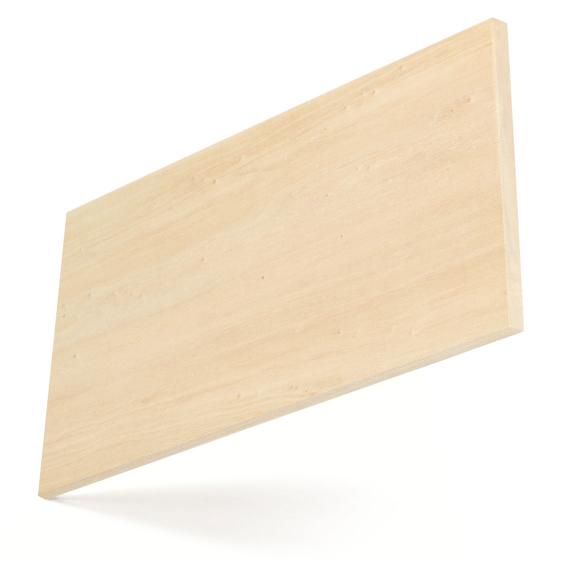
Forest Distribution
American eastern cottonwood trees are fast growing and the largest of this genus grows widely across the USA and is normally associated with water. They can be up to 8 feet in diameter. Cottonwood may be referred to as white poplar and should not be confused with tulipwood, known as yellow poplar in the USA.
FOREST GROWTH
FIA data shows U.S. cottonwood growing stock is 236 million m3, 1.5% of total U.S. hardwood growing stock. U.S. cottonwood is growing 4.3 million m3 per year while the harvest is 1.8 million m3 per year. The net volume (after harvest) is increasing 2.6 million m3 each year. American cottonwood growth exceeds harvest in all the main producing states except Maine (where it is mainly planted in urban areas), Nebraska and Texas. Cottonwoods are declining in some semi-arid areas of the U.S. due to drought, invasion of exotic species and overgrazing.
Material Availability
American cottonwood is available as sawn lumber and veneer but may only be available in limited volumes of export specifications, determined by current export demand. Cottonwood lumber is mainly available from southern producers predominantly in 4/4” (25.4mm) and 5/4” (32mm), where it needs to be processed quickly when freshly cut (green) to avoid checking and blue staining.
Wood Description
Cottonwood is a porous wood with a coarse texture. It is generally straight grained with relatively few defects. The sap is white, but may contain brown streaks. The heartwood is pale to light brown.
Mechanical Properties
The wood of cottonwood is relatively lightweight and soft. It is weak in bending and compression as well as shock resistance. Cottonwood has no taste or odour when dry.
-
0.4
Specific Gravity (12% M.C.)
449 kg/m3
Average Weight (12% M.C.)
11.30%
Average Volume Shrinkage (Green to 6% M.C.)
58.608 MPa
Modulus of Rupture
9,466 MPa
Modulus of Elasticity
33.854 MPa
Compressive strength (parallel to grain)
1,913 N
Hardness
Oiled / Un-Oiled Appearance


Performance
- Cottonwood presents some machining challenges, which can be overcome. The wood may produce a fuzzy or woolly surface when cut, so it is essential to use sharp blades set at the correct angle to avoid this problem. Otherwise it glues and screws well without splitting. It dries easily but with a tendency to warp, with small movement in performance.
- The wood is non-resistant to decay.
Main Uses
Traditionally used for venetian blinds, American cottonwood is used for furniture, especially reproduction furniture and furniture parts. Other uses include internal joinery and mouldings.
American elm
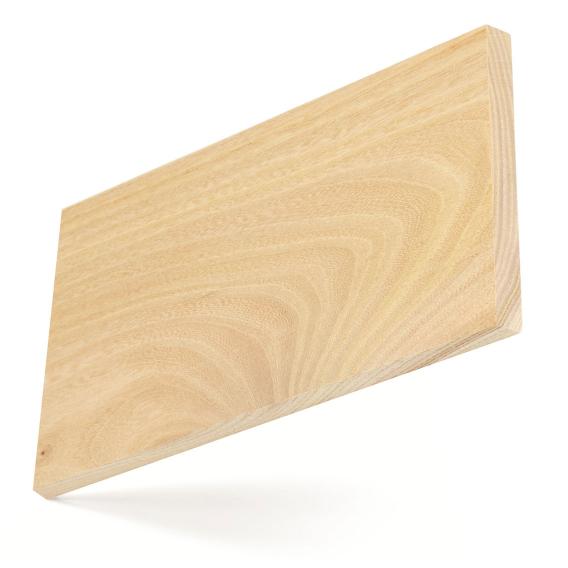
Forest Distribution
American red elm trees are now naturally regenerating in some regions making supplies patchy. Distribution is widespread but trees are greatly influenced by site conditions. Trees are relatively small, often with divided trunks.
FOREST GROWTH
FIA data shows U.S. elm growing stock is 298 million m3, 2.0% of total U.S. hardwood growing stock. American elm is growing 5.9 million m3 per year while the harvest is 2.5 million m3 per year. The net volume (after harvest) is increasing 3.41 million m3 each year. U.S. elm growth exceeds harvest in most significant producing states with the exception of Ohio. Despite surviving Dutch elm disease American elm is still susceptible to the disease which has impacted on growth and harvest in some States.
Material Availability
Elm from the USA is available in very limited commercial volumes and sawn lumber is produced mainly in 4/4" (25.4mm) thickness. As a result specifications and grades for export may be difficult to source on a regular basis. Veneer may also be available from specialist suppliers.
Wood Description
The close grain red elm may be straight or severely interlocked, with a coarse texture. The narrow sap is greyish white to light brown and the heartwood is light to dark brown in colour. Bird pecks are found in elm and are regarded as a natural characteristic and not considered a defect under NHLA Grading Rules.
Mechanical Properties
The wood of red elm is moderately heavy, hard and strong. It is stiff with excellent bending and shock resistance.
-
0.53
Specific Gravity (12% M.C.)
593 kg/m3
Average Weight (12% M.C.)
11%
Average Volume Shrinkage (Green to 6% M.C.)
89.635 MPa
Modulus of Rupture
10,274 MPa
Modulus of Elasticity
43.852 MPa
Compressive strength (parallel to grain)
3,825 N
Hardness
Oiled / Un-Oiled Appearance

Performance
- Red elm machines fairly well and it nails and screws easily. It glues well and can be sanded, stained and polished to a good finish. It dries well with minimum degrade and has little movement in performance.
- The wood is rated non-resistant to heartwood decay but is classed as permeable to preservatives.
Main Uses
American elm, when it is available is an attractive and desirable species for furniture and cabinet making and can also be used for internal joinery, flooring and panelling.
American sap gum

Forest Distribution
American gum trees are large with straight trunks growing widely across the South Eastern USA. There are several other, non-commercial, gums that also grow across the USA.
FOREST GROWTH
FIA data shows U.S. gum growing stock is 714.6 million m3, 4.9% of total U.S. hardwood growing stock. American gum is growing 22.9 million m3 per year while the harvest is 11.7 million m3 per year. The net volume (after harvest) is increasing 11.2 million m3 each year. U.S. gum growth exceeds or is in balance with harvest in all the main producing states.
Material Availability
American gum is available as sawn lumber and veneer in a variety of grades and sizes. It is usually sold as sapgum with no colour specification. Under NHLA Grading Rules each clear cutting must have one red (heartwood) face. When sorted for colour redgum (majority heartwood) is much more limited in availability. Lumber is more likely to be available in thinner stock (4/4” & 5/4”) and may be more limited in export markets.
Wood Description
Gum has a fine uniform texture, but has irregular grain, usually interlocked, often with an attractive grain figure. The sap of gum tends to be wide and is white to light pink in colour, whereas the heartwood is reddish brown, typically with dark streaks.
Mechanical Properties
The wood of gum is only moderately hard to soft, stiff and heavy, but has low steam bending classification. The wood is close grained.
-
0.62
Specific Gravity (12% M.C.)
689 kg/m3
Average Weight (12% M.C.)
13.40%
Average Volume Shrinkage (Green to 6% M.C.)
114.457 MPa
Modulus of Rupture
13,859 MPa
Modulus of Elasticity
56.332 MPa
Compressive strength (parallel to grain)
5,604 N
Hardness
Oiled / Un-Oiled Appearance


Performance
- Gum is easy to work with both hand and machine tools. It nails, screws and glues well, takes stain easily and can be sanded and polished to an excellent finish. Gum dries rapidly with a strong tendency to warp and twist. It has a large shrinkage and is liable to movement in performance.
- The wood is rated as non-resistant to decay. The heartwood is moderately resistant to preservative treatment, but the sap is permeable.
Main Uses
Main uses are cabinet making, furniture and furniture parts, doors, internal joinery and mouldings. Gum has been used and stained, as a substitute for walnut or mahogany.
American hackberry

Forest Distribution
American hackberry trees, are tolerant of a wide range of soils, so are quite widespread in the USA, growing in naturally regenerated forests mainly in the central and southern States, not to be confused with Mississippi hackberry (C. tenuifolia) that grows mainly near the Gulf coast. The trees of common hackberry can grow large, tall and straight with few lower branches for 70 feet yielding clear lumber.
FOREST GROWTH
FIA data shows U.S. hackberry growing stock is 138 million m3, 1.0% of total U.S. hardwood growing stock. Hackberry is growing 4.3 million m3 per year while the harvest is 1.2 million m3 per year. The net volume (after harvest) is increasing 3.1 million m3 each year. Hackberry growth rates are well above harvest rates in all significant producing states.
Material Availability
Hackberry is only available in very limited volumes of sawn lumber in export grades, and mostly as thinner material (4/4” & 5/4”) and produced mainly in the Southern USA. Veneer may also be available from specialist suppliers.
Wood Description
The wood of hackberry is similar to elm to which it is related, but although heavy is fairly soft and not very strong. The irregular coarse grain may be straight and sometimes interlocked, but it has a fine uniform texture. There is little difference between the sap and the heartwood which are yellowish grey to light brown in colour throughout.
Mechanical Properties
The wood of hackberry is moderately hard and heavy with good bending strength, but low in compression. It has high shock resistance and good steam bending classification, but is low in stiffness.
-
0.53
Specific Gravity (12% M.C.)
593 kg/m3
Average Weight (12% M.C.)
13.50%
Average Volume Shrinkage (Green to 6% M.C.)
76.535 MPa
Modulus of Rupture
8,205 MPa
Modulus of Elasticity
37.509 MPa
Compressive strength (parallel to grain)
3,914 N
Hardness
Oiled / Un-Oiled Appearance


Performance
- Hackberry planes and turns well, but is intermediate in its ability to hold nails and screws. It stains and polishes to a satisfactory standard. It dries easily with minimum degrade, but has high shrinkage and may be susceptible to movement in performance. Hackberry is susceptible to blue stain before and after kilning, so lumber purchased in the USA may be surfaced (planed) pre-shipment.
- The wood is non-resistant to heartwood decay and moderately resistant to preservative treatment.
Main Uses
Common hackberry is used for furniture and kitchen cabinets, internal joinery, doors and mouldings. It is also used as a substitute for ash.
American hickory
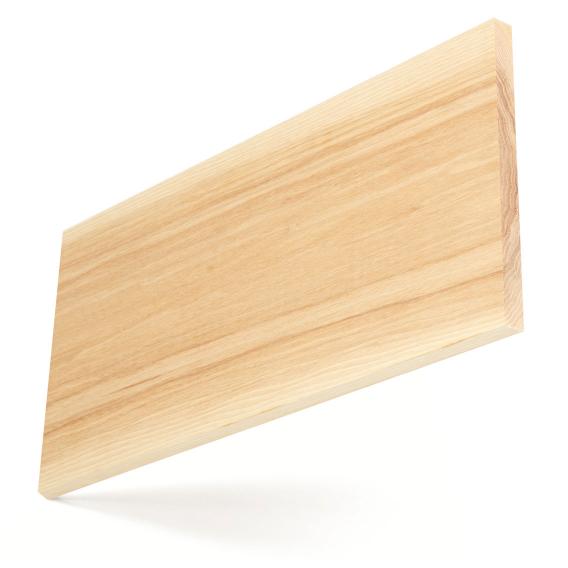
Forest Distribution
The hickories are an important group and the trees grow naturally throughout the Eastern U.S., from north to south. They are split into two groups; the more important true hickories and hickories producing pecan nuts, the latter being an important fruit-bearing tree. Trees vary in size enormously.
FOREST GROWTH
FIA data shows U.S. hickory growing stock is 742.3 million m3, 4.7% of total U.S. hardwood growing stock. American hickory is growing 14.6 million m3 per year while the harvest is 5.9 million m3 per year. The net volume (after harvest) is increasing 8.6 million m3 each year. U.S. hickory growth exceeds harvest in all significant producing states with the exception of Louisiana.
Material Availability
Hickory sawn lumber is readily available in export grades, but sold unselected for colour and mixed. The NHLA FAS grade permits a minimum width of 4 inches (101.6mm). The lower NHLA grades (1 & 2 Common) can produce an attractive and fashionable rustic look. Lumber is mainly produced in thinner stock (4/4” & 5/4) although a limited amount of thicker material may be available.
Wood Description
The wood of hickory varies greatly in colour, grain pattern and appearance from this very diverse group. It is fine textured and the grain is usually straight but can be wavy or irregular. The sapwood is white and maybe tinged with brown, while the heartwood is pale to yellow brown to dark in colour. Deep purple mineral streaks are a natural characteristic. Bird pecks are also a common characteristic and neither is considered a defect.
Mechanical Properties
The wood of hickories is rather coarse and varies from strong to less strong but is heavy and very hard. It has good bending strength, shock resistance and excellent steam bending properties.
-
0.75
Specific Gravity (12% M.C.)
833 kg/m3
Average Weight (12% M.C.)
14.3%
Average Volume Shrinkage (Green to 6% M.C.)
138.590 MPa
Modulus of Rupture
15,583 MPa
Modulus of Elasticity
63.365 MPa
Compressive strength (parallel to grain)
N/A
Hardness
Oiled / Un-Oiled Appearance


Performance
- Hickory is considered difficult to machine and glue, and very hard to work with hand tools. It will hold nails and screws well but tends to split so pre-boring is advised. The wood can be sanded and polished to a good finish. It can be difficult to dry and has large shrinkage, which may affect stability under variable moisture conditions and in wider width material.
- The wood is non-resistant to heartwood decay and classed as moderately resistant to preservative treatment.
Main Uses
Furniture, cabinetry, ladders, striking tool handles dowels and sporting goods. Traditionally used by wheelwrights and for making drumsticks. The hardwearing properties of hickory make it an excellent choice for flooring, especially in situations of high traffic use. Historically the first wooden golf club shafts were made from hickory, and NHLA lumber graders still use the traditional flexible hickory measuring stick.
American hard maple
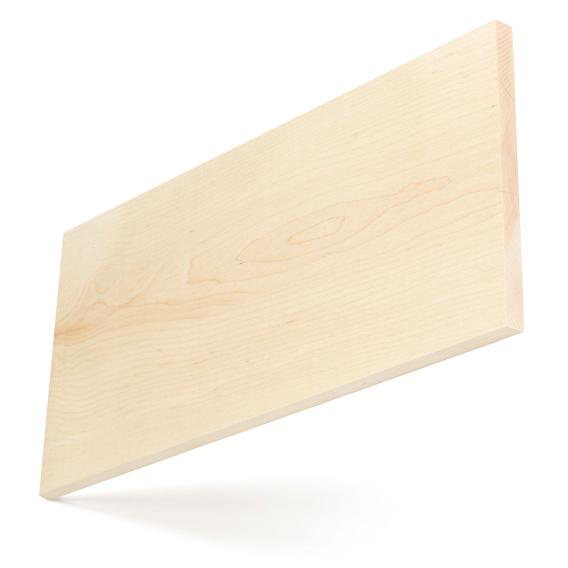
Forest Distribution
American hard maple is a cold climate species, although trees can grow throughout the USA in mixed hardwood forests, but favour the more northern states. The species is quite different from other maples throughout the world. The trees often grow in dense stands on many types of soil and are also farmed for their famous maple syrup. Harvesting the trees is seasonal (autumn and winter).
FOREST GROWTH
FIA data shows U.S. hard maple growing stock is 953.7 million m3, 6.6% of total U.S. hardwood growing stock. American hard maple is growing 19.1 million m3 per year while the harvest is 10.2 million m3 per year. Net volume (after harvest) is increasing 8.8 million m3 each year. U.S. hard maple growth exceeds harvest in all major supplying states except Maine. In Maine maple harvests have been high relative to growth, mainly due to increased extraction for pulpwood and bioenergy supplies, and because maple-dominated hardwood forests are slowly being replaced by softwood forest types.
Material Availability
- Hard maple from the USA is readily available as sawn lumber in a range of grades and sizes and as veneer. Lumber is regularly produced in 4/4" through to 8/4" but limited as thicker stock.
- The lumber may be sold according to (white) colour selection, for which a premium is normally charged. This is usually done using the NHLA grading standard for colour sorting producing colour grades such as "1&2 white". Consultation with suppliers is recommended.
Wood Description
- The sapwood of hard maple is normally creamy white but can show a slight reddish/brown tinge. White sapwood lumber can be selected and veneer is always selected. The heartwood of hard maple varies in colour from light to dark reddish brown and may also vary according to region. The difference between heart and sap colour may only be slight. Both may contain pith fleck as a natural characteristic.
- The wood of hard maple has a close fine texture and is generally straight grained. Hard maple can occur as 'curly', 'fiddleback' and 'birds eye' figure. The wood darkens on exposure to light with time.
Mechanical Properties
Hard maple is hard, as the name suggests, and is heavy with good strength properties. It has high resistance to abrasion and wear as well as good steam bending properties. Accordingly it is a preferred species for flooring, including sports floors, bowling alleys and worktops.
-
0.63
Specific Gravity (12% M.C.)
705 kg/m3
Average Weight (12% M.C.)
11.90%
Average Volume Shrinkage (Green to 6% M.C.)
108.941 MPa
Modulus of Rupture
12,618 MPa
Modulus of Elasticity
53.988 MPa
Compressive strength (parallel to grain)
6,450 N
Hardness
Oiled / Un-Oiled Appearance


Performance
- Hard maple lumber is excellent to machine, bore, turn and finish. It glues, planes, drills and carves well but screwing and nailing is only fair. It produces good mouldings. Hard maple can easily be sanded, stained and polished to a very fine and smooth finish.
- The heartwood is only slightly or non-resistant to decay and the heartwood is resistant to preservative treatment. The sapwood is permeable.
Main Uses
This sustainably managed wood from natural forests of North America, with excellent environmental credentials, is revered worldwide for its hardwearing property, delicate light colour and fine finish. It is highly suitable for all types of flooring, including high traffic areas such as public buildings, furniture, cabinet making and high-class joinery. It is widely used for table and work tops, mouldings, and kitchen cabinets.
American soft maple

Forest Distribution
American soft maples grow widely across the eastern USA in mixed hardwood forests with more red maple in the northeast and silver maple concentrated in the mid and southern states. The name can be misleading as soft maple is not technically very soft. There are a significant number of sub-species – all sold as soft maple. Several, including Pacific coast/big leaf maple (Acer macrophyllum), grow in the northwest USA, for which there are specific grading rules that apply.
FOREST GROWTH
FIA data shows U.S. soft maple growing stock is 1.62 billion m3, 11.1% of total U.S. hardwood growing stock. American soft maple is growing 36.4 million m3 per year while the harvest is 16.0 million m3 per year. The net volume (after harvest) is increasing 20.4 million m3 each year. U.S. soft maple growth exceeds harvest in all the main producing states.
Material Availability
Soft maple from the USA is widely available as sawn lumber in a range of sizes and grades, but rarely as veneer. The lumber is normally sold unselected for colour. West coast production is usually sold surfaced and graded from the better side, in a departure from standard NHLA Grading Rules.
Wood Description
- Soft maples are somewhat like hard maple, but much more variable in colour, especially from one region to another. The sapwood of soft maple is normally greyish white but can be darker, with pith flecks as a natural characteristic. The heartwood of soft maple varies in colour from light to dark reddish brown. The difference between sap and heartwood is greater than in hard maple.
- The wood of soft maple is generally straight grained with fine texture, with a grain pattern similar to American cherry, soft maple can be stained as a cherry substitute.
Mechanical Properties
Soft maple has good bending and crushing strength, but is low in stiffness and shock resistance. It is about 25% less hard than hard maple. Accordingly it is not recommended for flooring or work tops.
-
Acer Rubrum
0.54
Specific Gravity (12% M.C.)
609 kg/m3
Average Weight (12% M.C.)
10.50%
Average Volume Shrinkage (Green to 6% M.C.)
92.393 MPa
Modulus of Rupture
9,998 MPa
Modulus of Elasticity
45.093 MPa
Compressive strength (parallel to grain)
4,225 N
Hardness
-
Acer Macrophyllum
0.48
Specific Gravity (12% M.C.)
545 kg/m3
Average Weight (12% M.C.)
9.3%
Average Volume Shrinkage (Green to 6% M.C.)
73.777 MPa
Modulus of Rupture
11,308 MPa
Modulus of Elasticity
41.025 MPa
Compressive strength (parallel to grain)
3,780 N
Hardness
Oiled / Un-Oiled Appearance


Performance
- Soft maple lumber is excellent to machine, bore, plane and finish. It turns, glues, planes, drills and carves well but screwing and nailing is only fair. It produces good mouldings. Soft maple can easily be sanded, stained and polished to a fine and smooth finish, and has good steam bending properties. It is regarded as a substitute for cherry when stained. Its mechanical properties and performance also make it a substitute for beech.
- The wood is non-resistant to decay and the heartwood is moderately resistant topreservative treatment. The sapwood is permeable.
Main Uses
This highly sustainable, managed hardwood from natural forests of North America, with excellent environmental credentials, is considered where hardness and hardwearing properties may not be essential. It is used in furniture, cabinet making and joinery as well as doors, kitchen cabinets and for turning and mouldings.
American white oak
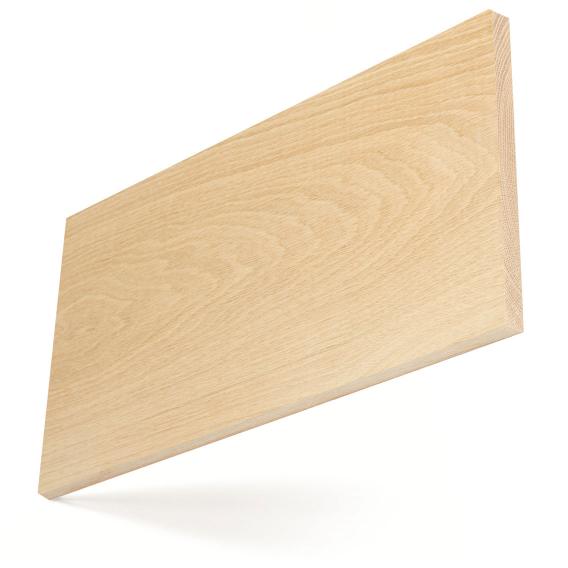
Forest Distribution
White oak trees grow exclusively in North America and are widely distributed throughout most of the eastern United States in mixed hardwood forests. As with red oak there are many sub-species, all within the white oak classification, and together form the most common species group accounting for about 33% of the American hardwood resource. The trees are tall and easily identified by their rounded leaf form, turning brown in the fall. White oaks also grow from north to south; some high in the mountains and others on low land giving rise to different characteristics. Thus there are significant variations in white oaks depending on location, in particular between the slower grown northern and faster grown southern trees. As with red oaks, they are regarded as sustainable for both domestic andexport consumption.
FOREST GROWTH
FIA data shows U.S. white oak growing stock is 2.26 billion m3, 15.5% of total U.S. hardwood growing stock. American white oak is growing 40.1 million m3 per year while the harvest is 20.1 million m3 per year. The net volume (after harvest) is increasing 20.0 million m3 each year. U.S. white oak growth exceeds harvest in all major supplying states.
Material Availability
White oak from the USA is readily available as sawn lumber and veneer, in a wide range of grades and sizes. Due to lengthy drying times not all suppliers offer thicker lumber stock (10/4" & 12/4") but it is available in limited volumes. In the north the sapwood tends to be less than in the south where, due to the shorter growing season, the wood is grown faster with more open grain and texture. White oak may be sold on the basis of 'northern' and 'southern', but this may be an over-simplification of the differences according to growing location.
Wood Description
- White oaks have an attractive grain, similar to many other oaks grown globally. In general the sapwood of white oak is whitish to light brown and the heartwood is normally light to mid or even dark brown. The difference between the sapwood and heartwood of white oak is less distinct than in red oak. The wood of white oaks is mainly straight-grained with medium to coarse texture.
- The wood is figured with medullary rays – a feature of all true (Quercus) oaks – and these in white oak are longer than those of red oak; thus producing a more pronounced figure. The heartwood wood is not porous, so is suitable for wine barrels and exterior use.
Mechanical Properties
American white oaks have excellent overall strength properties relative to weight, making them a preferred hardwood species for structural applications. The wood is hard and relatively heavy with good bending strength and compression strength but lower in stiffness. Structural testing carried out in Europe confirms that the white oak has greater inherent fibre strength than European oak. It has excellent steam bending capability. Being hard, stable when dry and easy to finish and stain, it is highly popular for furniture and flooring, especially in export markets.
To find out more about the mechanical properties of white oak read the full structural guide.
-
0.68
Specific Gravity (12% M.C.)
769 kg/m3
Average Weight (12% M.C.)
12,273 MPa
Average Volume Shrinkage (Green to 6% M.C.)
104.804 MPa
Modulus of Rupture
12,273 MPa
Modulus of Elasticity
51.299 MPa
Compressive strength (parallel to grain)
6,049 N
Hardness
Oiled / Un-Oiled Appearance


Performance
- White oak lumber machines well, with good performance in nailing and screwing, although pre-boring is recommended. It glues well (although the inclusion of primers are recommended for structural gluing) and can be stained and polished to a very good finish. The wood has to be dried slowly and carefully to avoid degrade and it has high differential radial and tangential shrinkage so can be susceptible to movement in performance in humid conditions. It has excellent drilling and finishing properties.
- The heartwood is resistant to decay and resistant to preservative treatment.
Main Uses
This sustainably managed wood from natural forests of North America, with excellent environmental credentials, is a key species in many export markets. Its main uses are in furniture, flooring, doors, architectural joinery and mouldings and kitchen cabinets. It is also used in certain applications for construction, including structural glue-laminated beams, and other specialist applications.
American pecan
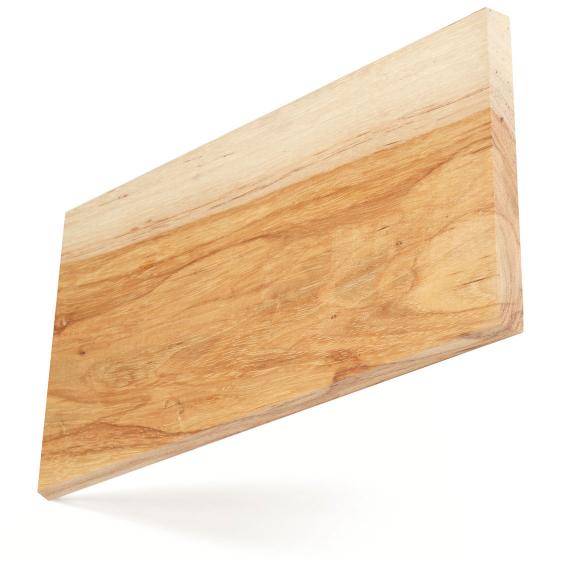
Forest Distribution
Pecan trees grow naturally in the south eastern USA and principally in the Mississippi valley. It is an important fruit-bearing tree and varies in size enormously.
FOREST GROWTH
FIA data shows U.S. pecan growing stock is 46.8 million m3, 0.3% of total U.S. hardwood growing stock. American pecan is growing 931,000 m3 per year while the harvest is 355,000 m3 per year. The net volume (after harvest) is increasing 576,000 m3 each year. U.S. pecan growth considerably exceeds harvest in the four main producing states of Arkansas, Kansas, Louisiana, and Mississippi.
Material Availability
Pecan sawn lumber is available in export grades, but sold unselected for colour and mixed. The NHLA FAS grade permits a minimum width of 4 inches (101.6mm). The lower NHLA grades (1 & 2 Common) can produce an attractive and fashionable rustic look. Lumber is mainly produced in thinner stock (4/4” & 5/4) although a limited amount of thicker material may be available.
Wood Description
The wood of pecan varies greatly in colour, grain pattern and appearance from this very diverse group. It is coarsely textured and the grain is usually straight but can be wavy or irregular. The sapwood is white and maybe tinged with brown, while the heartwood is pale to yellow brown to dark in colour. Deep purple mineral streaks are a natural characteristic. Bird pecks are also a common characteristic and neither is considered a defect.
Mechanical Properties
The wood of pecan is usually considered very strong with excellent stem bending classification, high crushing strength, high stiffness and very high shock resistance.
-
0.66
Specific Gravity (12% M.C.)
737 kg/m3
Average Weight (12% M.C.)
N/A
Average Volume Shrinkage (Green to 6% M.C.)
94.462 MPa
Modulus of Rupture
11,928 MPa
Modulus of Elasticity
54.126 MPa
Compressive strength (parallel to grain)
8,095 N
Hardness
Oiled / Un-Oiled Appearance


Performance
- Pecan is considered to have good machining properties resembling those of hickory but difficult to glue, and is very hard to work with hand tools. It holds nails and screws well but tend to split, so pre-boring is advised. The wood can be sanded, stained and polished to a good finish. It can be readily dried but has fairly high shrinkage.
- The wood is non-resistant to heartwood decay and classed as moderately resistant to preservative treatment.
Main Uses
Furniture, cabinetry, ladder rungs, tool handles dowels and sporting goods. Particularly hockey sticks due to its flexibility.
American sassafras
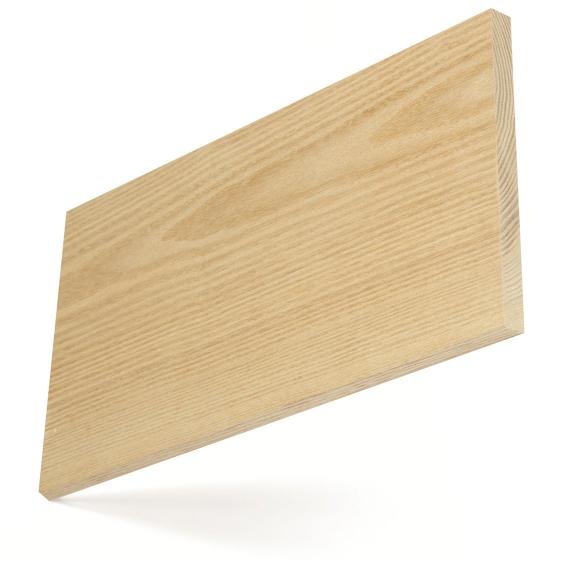
Forest Distribution
American sassafras trees grow small in the north and tend to develop pockets around parent trees. They are distributed throughout the eastern, central and southern USA and as far west as eastern Texas in natural hardwood forests on all types of soil.
FOREST GROWTH
Forest Inventory Analysis (FIA) data shows U.S. sassafras growing stock is 45 million m3, only 0.3% of total U.S. hardwood growing stock. American sassafras is growing 527,000 m3 per year while the harvest is 480,000 m3 per year. The net volume (after harvest) is increasing 47,000 m3 each year.
Material Availability
Sassafras lumber from the USA is rarely available and only in limited volumes mainly from southern producers. Check with suppliers for grades available for export. Veneer may also available from specialist suppliers.
Wood Description
The heartwood of sassafras is pale to dark brown but often golden in colour. It is a soft light flexible wood. The grain may be interlocked, can be straight but is often wavy and can produce a highly attractive fiddleback pattern. The wood may have a coarse or fairly fine texture and the grain has an ash-like appearance and resembles chestnut.
Mechanical Properties
Sassafras is medium in hardness and shock resistance, but low in stiffness. It is has good bending qualities and is easy to turn on the lathe.
-
0.42
Specific Gravity (12% M.C.)
497Kg/m3
Average Weight (12% M.C.)
8.2%
Average Volume Shrinkage (Green to 6% M.C.)
62.055 MPa
Modulus of Rupture
7,722 MPa
Modulus of Elasticity
32.820 MPa
Compressive strength (parallel to grain)
2,802 N
Hardness
Oiled / Un-Oiled Appearance


Performance
- Sassafras machines and works reasonably well, but tools should be kept sharp. It requires pre-boring for nailing and holds screws well. The wood glues very well and stains and polishes with care to a good finish. It requires care in drying as it has a marked tendency to check and cup. It has moderate shrinkage and little movement in performance.
- The wood is resistant to heartwood decay and is moderately resistant to preservative treatment.
Main Uses
American sassafras, growing in natural forests in the USA, is considered highly suitable for several aromatic uses including staves for buckets and some furniture.
American sycamore
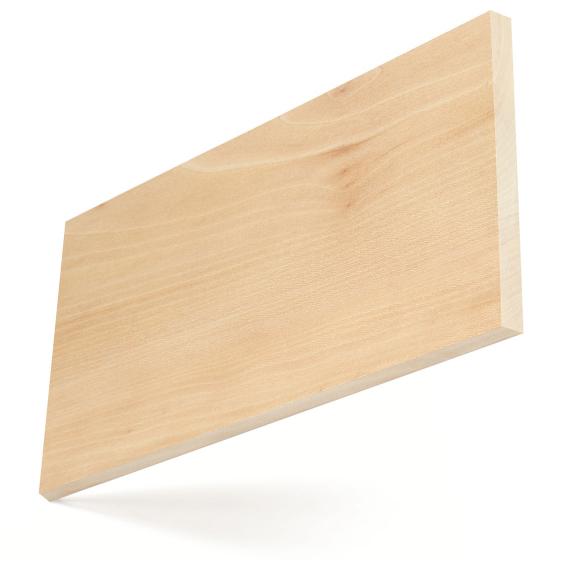
Forest Distribution
American sycamore trees are generally huge, being one of the largest hardwood species in North America, growing throughout the eastern and central USA in natural hardwood forests. Several other American planes, as they are called, grow in California and Arizona but are not commercially significant.
FOREST GROWTH
FIA data shows sycamore growing stock in the U.S. (excluding California and Arizona) is 144.5 million m3, 1% of total U.S. hardwood growing stock. American sycamore is growing 4.00 million m3 per year while the harvest is 1.22 million m3 per year. The net volume (after harvest) is increasing 2.78 million m3 each year. U.S. sycamore growth exceeds harvest in all supplying states.
Material Availability
Sycamore lumber from the USA is available in limited volumes mainly from southern producers and more easily sourced as thinner stock (4/4" & 5/4"). Check with suppliers for grades available for export. Veneer is also available from specialist suppliers.
Wood Description
The wood of sycamore may display a variety of colours. The sap is white to light yellow in colour and the heartwood is light to dark brown. The wood of sycamore has a fine close texture and is interlocked. The grain is distinct with a characteristic fleck.
Mechanical Properties
Sycamore is moderate in weight, hardness, stiffness and shock resistance. It is heavy and tough. It has good bending qualities and is easy to turn on the lathe.
-
0.49
Specific Gravity (12% M.C.)
545 kg/m3
Average Weight (12% M.C.)
11.40%
Average Volume Shrinkage (Green to 6% M.C.)
68.950 MPa
Modulus of Rupture
9,791 MPa
Modulus of Elasticity
37.095 MPa
Compressive strength (parallel to grain)
3,425 N
Hardness
Oiled / Un-Oiled Appearance


Performance
- Sycamore machines and works well, but high speed cutters are required to avoid chipping. It is resistant to splitting due to its interlocked grain. The wood glues well and stains and polishes with care to an excellent finish. It dries rapidly and has a tendency to warp. It has moderate shrinkage and little movement in performance.
- The wood is non-resistant to heartwood decay but is permeable to preservative treatment.
Main Uses
American sycamore, growing in natural forests in the USA, is considered highly suitable for cabinetry and furniture. It is used for mouldings, internal joinery and veneered panels. Specialist uses include butcher blocks.
American tulipwood
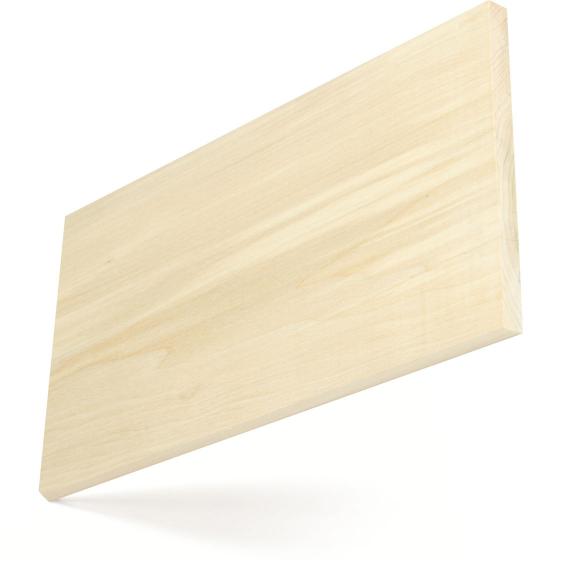
Forest Distribution
Tulipwood trees grow exclusively in North America and are widely distributed throughout most of the eastern United States in mixed hardwood forests. It is a single species and is not a poplar (Populus) being a Magnoliacae producing wood that is superior to the many poplar species. The trees are huge and identified by their tulip-like flowers giving rise to the name. Tulipwood grows from north to south and is one of the most sustainable hardwoods in the USA.
FOREST GROWTH
FIA data shows U.S. tulipwood growing stock is 1.12 billion m3, 7.7% of total U.S. hardwood growing stock. American tulipwood is growing 34.6 million m3 per year while the harvest is 12.8 million m3 per year. The net volume (after harvest) is increasing 21.8 million m3 each year. U.S. tulipwood growth exceeds harvest in all states.
Material Availability
Tulipwood from the USA is readily available as sawn lumber in a wide range of grades and thicknesses (4/4” through to 16/4”) due to its ease of drying. A relative knot free timber average lumber widths and lengths can be higher than other commercial species. Tulipwood is used in plywood production but with more limited availability as decorative veneer. The sapwood produces the often preferred whiter wood, as the heartwood usually exhibits strong colour variation. However the use of unsorted tulipwood displaying all its natural colour variation is on the increase, especially in Europe. Tulipwood is sold domestically, and sometimes referred to in export, as ‘poplar’ but should not be confused with European or Chinese poplar.
Wood Description
Tulipwood has less strong grain characteristic than species such as ash and oak, and is more like maple in character but darker in colour. However, there is a marked difference between the sapwood and heartwood of tulipwood. The sapwood is creamy white whereas the heartwood can vary from pale yellow or brown and even green to purple in extreme cases. The wood darkens with time on exposure to UV light and the green colour will turn brown. The wood of tulipwood is straight-grained with a medium to fine texture.
Mechanical Properties
Tulipwood has extraordinary overall strength properties relative to weight, making it highly suitable for structural applications, such as glue-laminated beams and cross laminated timber (CLT). The wood has relative low density, with high bending, shock resistance, and stiffness values, but is lower in compression and hardness. The wood has medium steam-bending capability and is extremely stable when fully dry and not installed in humid conditions. It is easy to finish and stain, so is highly suitable for furniture and joinery.
To find out more about the mechanical properties of tulipwood read the full structural guide.
-
0.42
Specific Gravity (12% M.C.)
449 kg/m3
Average Weight (12% M.C.)
9.80%
Average Volume Shrinkage (Green to 6% M.C.)
69.640 MPa
Modulus of Rupture
10,894 MPa
Modulus of Elasticity
38.198 MPa
Compressive strength (parallel to grain)
2,402 N
Hardness
Oiled / Un-Oiled Appearance


Performance
- Tulipwood lumber is easy to machine, plane, turn and glue with good performance screwing, although pre-boring is recommended. It tends to split when nailed. Tulipwood can easily be stained and polished to a very good finish. The wood can be susceptible to movement in performance in humid conditions.
- The wood is non-resistant to decay. The heartwood can be resistant to preservative treatment, whereas the sap is permeable. Overall, tulipwood can be considered for preservation with modern preservation treatment methods including thermal modification, to which it is particular suited.
Main Uses
This sustainably managed wood from natural forests of North America, with excellent environmental credentials, is a key species in many export markets. Its main uses are in furniture, doors, panelling, architectural interior joinery and mouldings and kitchen cabinets. It is also used in certain applications for construction and in some specialist applications such as carving.
American walnut
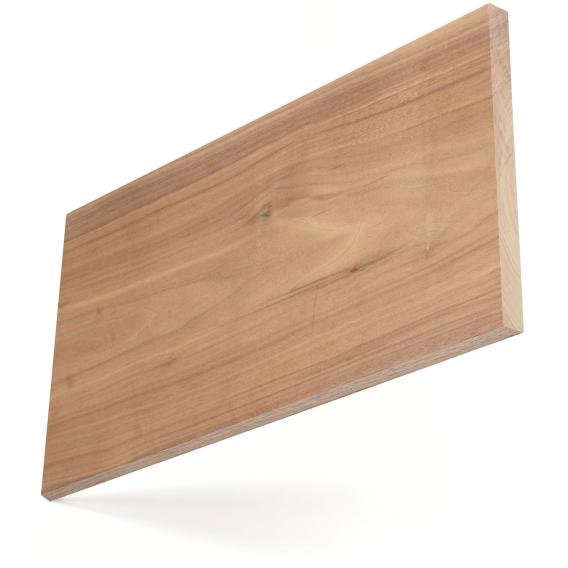
Forest Distribution
American walnut trees grow very widely across the eastern USA in mixed hardwood forests and on farms, concentrated in central states but spread from Texas to the eastern seaboard. The trees are one of the few hardwood species planted as well as occurring and regenerated naturally. They grow relatively tall and straight with few lower branches.
FOREST GROWTH
FIA data shows U.S. walnut growing stock is 137.8 million m3, 0.9% of total U.S. hardwood growing stock. American walnut is growing 4.8 million m3 per year while the harvest is 1.9 million m3 per year. The net volume (after harvest) is increasing 2.9 million m3 each year. U.S. walnut growth exceeds harvest in all major supplying states except Michigan.
Material Availability
Walnut from the USA is available as sawn lumber and as veneer. The lumber is generally sold un-steamed and unselected for colour. Specialist producers may offer steamed walnut intended to darken the sapwood and thus reduce the colour difference between heartwood and sapwood. Recent years have seen huge global demand for this species. NHLA Grading Rules are modified for walnut, allowing smaller specifications and smaller clear cuttings and sapwood is admitted without limit. Consultation with suppliers is recommended.
Wood Description
- The sapwood of walnut is creamy white, whereas the heartwood is light brown to dark chocolate brown, making the difference in colour quite distinct. Occasionally the heartwood has dark, even purple, streaks. The wood of walnut is generally straight grained, although sometimes with wavy or curly grain that produces its characteristic and attractive figure, sought after by designers.
- American walnut is quite different to European walnut, which tends to be lighter in colour.
Mechanical Properties
Walnut is tough, hard and of medium density. It has moderate bending and crushing strengths and is low in stiffness. It has good steam bending classification.
-
0.55
Specific Gravity (12% M.C.)
609 kg/m3
Average Weight (12% M.C.)
10.20%
Average Volume Shrinkage (Green to 6% M.C.)
100.677 MPa
Modulus of Rupture
11,584 MPa
Modulus of Elasticity
52.264 MPa
Compressive strength (parallel to grain)
4,492 N
Hardness
Oiled / Un-Oiled Appearance


Performance
- American walnut works easily with hand and machine tools. It has excellent planing, turning and moulding properties. It has good nailing and gluing properties and can be stained and polished to an excellent finish. The wood dries slowly and has good dimensional stability when dry.
- The wood is rated as very resistant to heartwood decay and is one of the most durable (decay resistant) American hardwoods.
Main Uses
Walnut is considered one of the supreme species for high end furniture, cabinets, doors and interior joinery. It is used for flooring and panelling and it is widely used to contrast with other hardwoods.
American willow
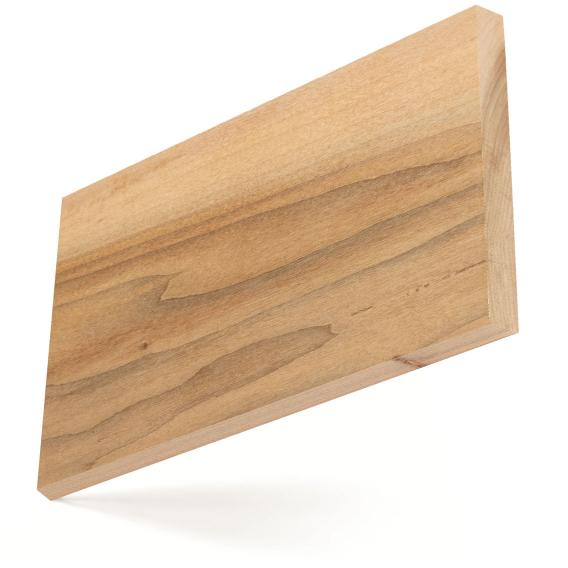
Forest Distribution
American black willow trees grow naturally in the Central and Southern States mainly along the Mississippi river and beside lakes. The best trees of willow can grow very tall and straight but with relatively small diameter and may be multi-stemmed.
FOREST GROWTH
FIA data shows U.S. willow growing stock is 56.7 million m3, 0.4% of total U.S. hardwood growing stock. American willow is growing 1.15 million m3 per year while the harvest is 0.31 million m3 per year. The net volume (after harvest) is increasing 0.84 million m3 each year. Willow growth exceeds harvest in most U.S. states that are host to the species
Material Availability
Willow is only available on a regional basis mainly in the southern States and in limited volumes of sawn lumber in export grades. It is primarily produced as thinner stock (4/4") so the availability of other thicknesses may be more limited. Veneer may also be available from specialist suppliers.
Wood Description
The wood of willow has a fine and even texture. The grain may straight or interlocked and may present attractive figure. The narrow sapwood varies according to site conditions and is light to creamy brown in colour but can be almost white. The heartwood is distinct ranging from pale reddish brown to greyish brown and can be quite dark. Burls and swirls in the grain are natural characteristics and are not considered defects.
Mechanical Properties
The wood of willow is light in weight and soft. It is weak in bending strength, compression, shock resistance, stiffness and has low steam bending classification.
-
0.39
Specific Gravity (12% M.C.)
417 kg/m3
Average Weight (12% M.C.)
11.50%
Average Volume Shrinkage (Green to 6% M.C.)
53.800 MPa
Modulus of Rupture
6,960 MPa
Modulus of Elasticity
28.300 MPa
Compressive strength (parallel to grain)
N/A
Hardness
Oiled / Un-Oiled Appearance


Performance
- Willow works fairly well with machine and hand tools, but care is needed to avoid a fuzzy surface when interlocked grain is present. It nails and screws well and has excellent gluing properties and can be sanded and polished to a very good finish. It dries rapidly with minimum degrade, although it may be susceptible to moisture pockets. Willow shrinks as it dries but its dimensional stability is good when dry.
- The wood is non-resistant to heartwood decay and resistant to preservative treatment. The sapwood is permeable.
Main Uses
Black willow is used for furniture, joinery and interior mouldings. It can be used stained as a light coloured substitute for walnut.
American beech

Forest Distribution
American beech trees grow widely across the eastern USA in mixed hardwood forests, although are concentrated in the central areas of the eastern States. American beech is different to European beech as the trees grow less tall and generally less straight and are frequently multi-stemmed in older stands.
FOREST GROWTH
Forest Inventory Analysis (FIA) data shows U.S. beech growing stock is 348 million m3, 2.6% of total U.S. hardwood growing stock. U.S. beech is growing 4.5 million m3 per year while the harvest is 3.8 million m3 per year. The net volume (after harvest) is increasing 0.7 million m3 each year.
Material Availability
Beech from the USA has limited availability as sawn lumber, especially in higher grades and thicker sizes. This is attributed partly to the fact that most parcels of mixed species logs do not contain sufficient beech to produce a full charge for kiln drying. Furthermore beech, which is rather difficult to dry, requires a particular kiln schedule and cannot easily be mixed with other species. For this reason availability is mainly from specialist producers who can also usually supply steamed beech. The lumber is normally sold unselected for colour and mainly in thicker specifications. Beech veneer is rarely available.
Wood Description
American beech tends to be darker in colour and less consistent than European beech. The sapwood is almost white with a red tinge and the heartwood is light to dark reddish brown. The wood of beech is generally straight and close grained with uniform texture. It has medium bending and crushing strength, but is low in stiffness and shock resistance. The wood may exhibit brown mineral streaks in the heartwood which, under NHLA Grading Rules, are not considered a defect.
Mechanical Properties
Beech is heavy, hard and reasonably strong. It has high resistance to shock and is very suitable for steam bending.
-
0.64
Specific Gravity (12% M.C.)
721 kg/m3
Average Weight (12% M.C.)
13.00%
Average Volume Shrinkage (Green to 6% M.C.)
102.736 MPa
Modulus of Rupture
11,859 MPa
Modulus of Elasticity
50.334 MPa
Compressive strength (parallel to grain)
5,782 N
Hardness
Oiled / Un-Oiled Appearance
Performance
- American beech works well with most hand and machine tools. It has good nailing and gluing properties and can be stained and polished to a good finish. The wood dries fast and tends to warp, split and is subject to surface checks when dry. It is prone to large shrinkage on drying and will move in humid conditions.
- The wood is non-resistant to heartwood decay but is permeable for preservative treatment.
Main Uses
Beech is considered suitable where hardness and hardwearing properties may be essential. It is used in furniture, doors, flooring and panelling. It has specialist applications including tool and brush handles as it is easy to turn. Having no smell or taste, it is suitable for food containers.
American yellow birch
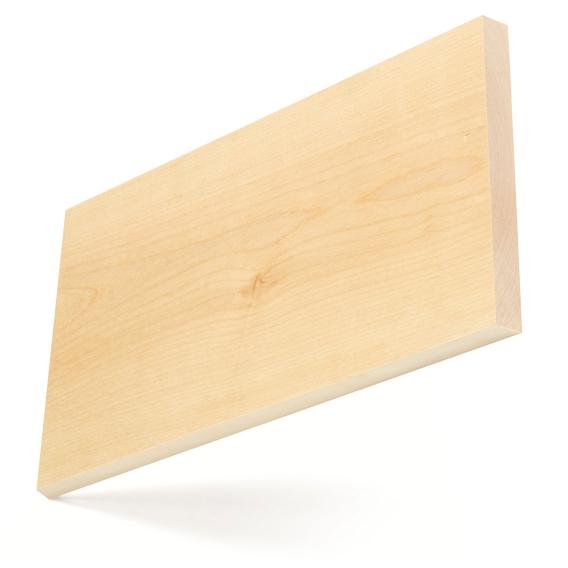
Forest Distribution
American yellow birch trees are generally not too large in this pioneer species that can be overgrown by climax species, such as maple. Definitely a northern, cold climate tree, yellow birch is medium sized with a medium diameter although larger trees can grow infrequently. Yellow birch should not be confused with paper birch, which is softer in texture and lighter in colour with scattered brown flecks.
FOREST GROWTH
Forest Inventory Analysis (FIA) data shows U.S. yellow birch growing stock is 541 million m3, 3.7% of total U.S. hardwood growing stock. American yellow birch is growing 7.09 million m3 per year while the harvest is 4.8 million m3 per year. The net volume (after harvest) is increasing 2.28 million m3 each year. U.S. yellow birch growth exceeds harvest in most of the main producing states including Maine, New Hampshire, New York, Pennsylvania and Vermont.
Material Availability
Birch from the USA is available in limited volumes as sawn lumber unselected for colour but more limited in sizes and grades if red heartwood or white sapwood is specified. When selected for colour FAS grade will allow 5 inch minimum width. Refer to NHLA Grading Rules for colour sorting specifications. Birch is more likely to be available in thinner sizes 4/4” (25.4mm) & 5/4” (32mm). Veneer may also be available from specialist suppliers.
Wood Description
The wood of yellow birch has a distinct difference between the sap which is white and the heartwood which is light reddish brown. The wood is generally straight grained with a fine uniform texture.
Mechanical Properties
Birch is heavy, hard and strong. It has very good wood bending qualities with good crushing strength and shock resistance.
-
0.62
Specific Gravity (12% M.C.)
689 kg/m3
Average Weight (12% M.C.)
13.40%
Average Volume Shrinkage (Green to 6% M.C.)
114.457 MPa
Modulus of Rupture
13,859 MPa
Modulus of Elasticity
56.332 MPa
Compressive strength (parallel to grain)
5,604 N
Hardness
Oiled / Un-Oiled Appearance


Performance
- Birch machines fairly easily and works well with care, including turning and takes stains and polish extremely well. It nails and screws satisfactorily where pre-boring is recommended. It dries rather slowly with little degrade, but has a moderately high shrinkage, so may move in performance.
- The wood is non-resistant to heartwood decay but is moderately resistance to preservative treatment and the sapwood is permeable.
Main Uses
American yellow birch, growing sustainably in the natural forests in the USA, is used for some furniture and joinery, such as doors and interior panelling and kitchen cabinets.
